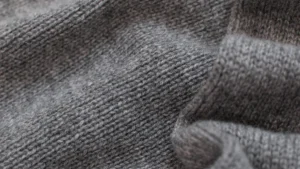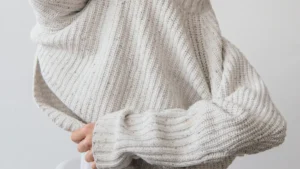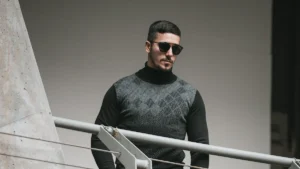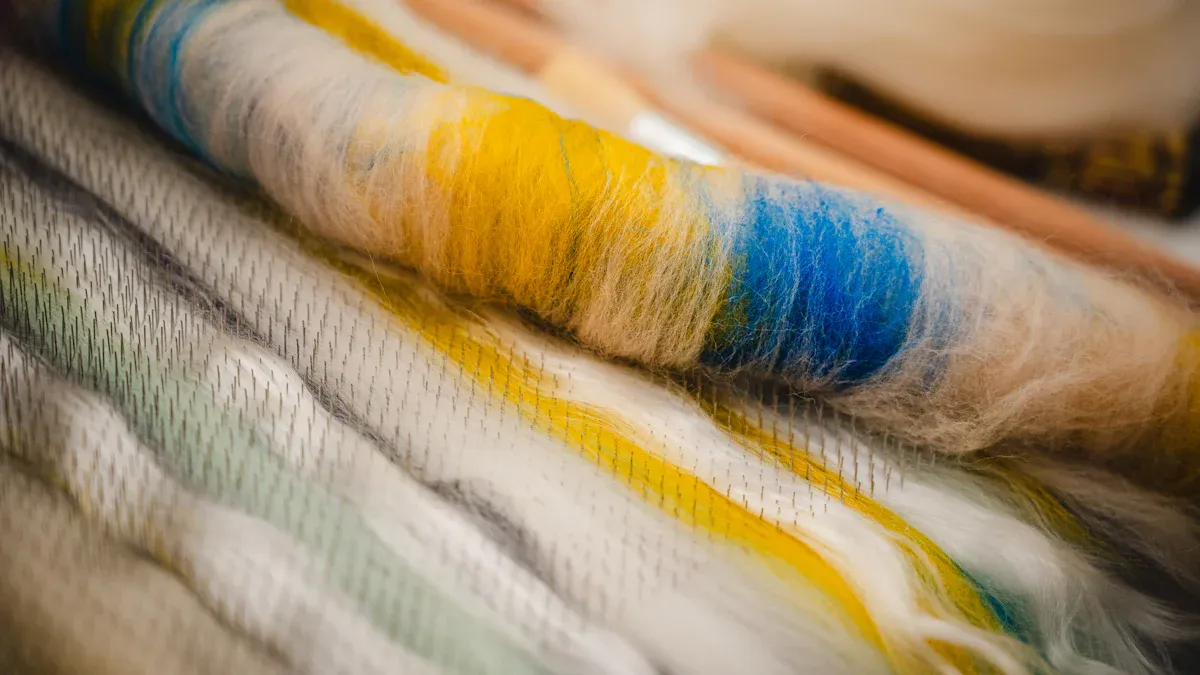
You might know angora knitting wool for being extremely soft and warm. This angora knitting wool is sourced from angora rabbits. It is easy to recognize because it looks fluffy and feels gentle to the touch. Angora knitting wool is lighter and softer than most other types of yarn. People who want something luxurious often choose angora knitting wool for their projects. The fibers are very fine, about 13 microns thick, which gives angora knitting wool a silky feel similar to other high-end fibers. Here’s how angora knitting wool compares in softness:
Fiber | Micron Count (microns) |
|---|---|
Shahtoosh | 7 – 12 |
Vicuña | ~12 |
Qiviut down | 12 – 14 |
Angora Wool | 12 – 16 |
Angora fabric is made from angora knitting wool collected from angora rabbits. It not only looks beautiful but is also very practical. Many knitters prefer angora knitting wool because of its high quality. It also gives any angora fabric a fancy appearance. Angora knitting wool is more affordable than some other luxury fibers, so you can enjoy its benefits without spending too much. Since angora rabbits produce wool frequently, angora knitting wool and fabric are easy to find. When you touch angora knitting wool, you’ll understand why angora fabric is known for its elegance and softness.
Key Takeaways
Angora wool is from angora rabbits. It feels very soft and light. It is also warm because its fibers are fine and hollow. The fluffy halo on angora yarn gives more warmth. It also makes your projects look soft and pretty. Angora yarn works best for cozy and fancy clothes. People use it for scarves, hats, and sweaters. It is often mixed with other fibers to make it stronger. Pick angora fabric from farms that are kind to rabbits. These farms use gentle ways to collect the wool. This helps animal welfare. Take care of angora by washing it by hand in cold water. Lay it flat to dry. This keeps it soft and in good shape for a long time.
Angora Knitting Wool
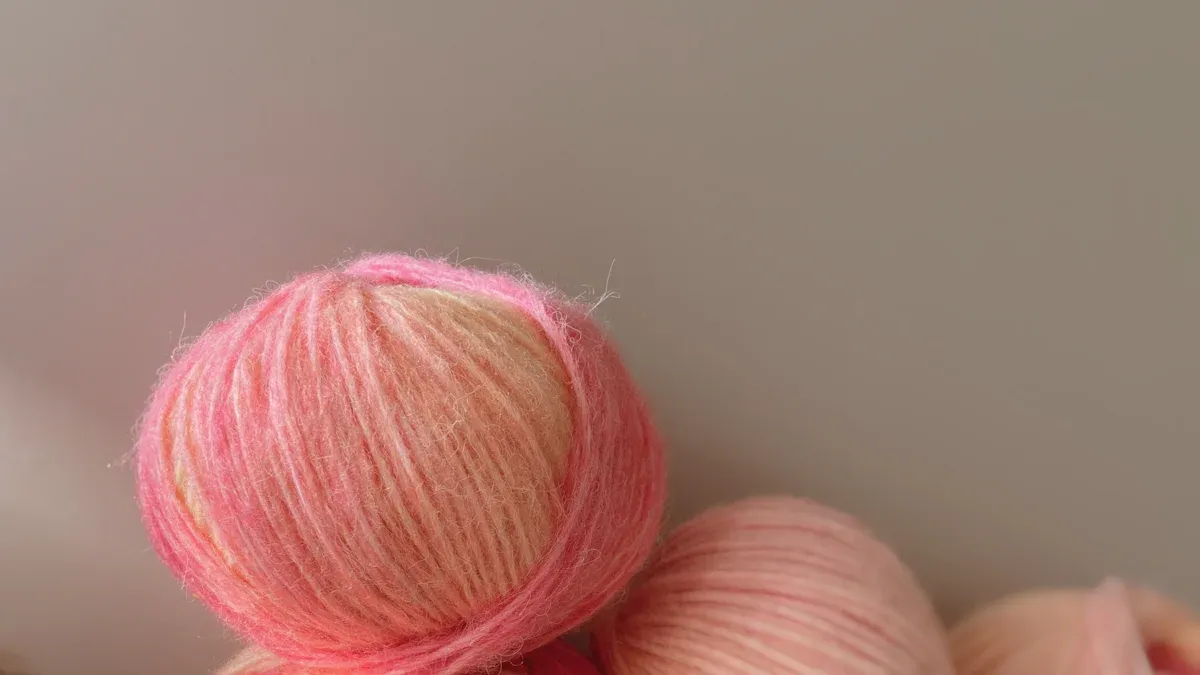
What Is Angora Wool
Angora wool is different from other animal fibers. It comes from angora rabbits. This wool is known for being very soft and fluffy. When you touch angora knitting wool, it feels silky and light. It is lighter than most other wool. Angora wool is one of the finest fibers. Its thickness is only 12 to 16 microns. This makes it even softer than cashmere. Cashmere is usually about 18 microns thick.
Here are some main things that make angora wool special:
It comes from angora rabbits, not goats or sheep.
It is very soft, fine, and fluffy.
It keeps heat well because of hollow hair.
It is hypoallergenic, so people with allergies can use it.
It lets air pass through and stretches easily.
It can get matted, so you must handle it gently.
It is delicate and fancy, used in fine knitwear.
It costs more because it is rare and hard to make.
Angora wool is a fancy and delicate fiber. You often see it in soft sweaters, scarves, and other nice clothes. It is not used for work clothes because it is more delicate. The quality depends on the rabbit’s age, health, and stress. Because it is rare, angora wool is more expensive than other fibers.
You can compare angora wool to other fibers in this table:
Characteristic | Angora Wool Description |
|---|---|
Origin | Comes from angora rabbits’ coats |
Fiber Fineness | 12-16 microns, one of the finest |
Softness and Silkiness | Very soft and silky |
Fluffiness | Very fluffy |
Heat Retention | Keeps heat well because of hollow hairs |
Hypoallergenic | Yes, good for people with allergies |
Breathability | Lets air pass through easily |
Moisture-wicking | Medium at moving moisture away |
Stretchability | Stretches easily |
Prone to Matting | Yes, needs gentle handling |
Softer and finer; mohair is shinier and rougher | |
Softer and finer; cashmere is thicker (about 18 microns) | |
Usage | Used for luxury sweaters, scarves, gloves, coats, and fine knitwear |
Price and Ethical Issues | Costs more because it is delicate and hard to produce |
Source: Angora Rabbits
Angora rabbits make the special fiber in angora knitting wool. These rabbits have long, soft fur that grows fast. This means you can get more wool often. There are three main ways to collect angora rabbit wool. You can pluck, shear, or comb the wool.
Method | Description | Advantages | Disadvantages |
|---|---|---|---|
Plucking | Take out the long, grown hairs by hand during molting. | Gives the best fiber (long, clean hairs); best for top quality. | Some people think it is cruel if done wrong; needs skill and care. |
Shearing | Cut the fur with scissors or shears, like a haircut. | Fastest way; does not hurt more than a haircut; good for rabbits that do not shed. | Fiber is lower quality because it mixes long and short hairs; short hairs fall out of yarn. |
Combing | Use a comb to brush off loose hairs. | Faster than plucking but slower than shearing; good fiber quality; relaxing for the rabbit. | Takes more time than shearing; fiber is not as good as plucking but better than shearing. |
You can collect angora rabbit wool every few months. The rabbits grow new fur quickly. This makes angora fiber a resource you can use again and again. How you collect the fiber changes its quality. Plucking gives the longest and cleanest fibers but takes more time and skill. Shearing is faster and easier, but the wool has more short hairs. Combing is in the middle for speed and quality.
Different angora rabbit breeds make different types of angora fiber. Each breed has its own traits. These traits change how soft, how much, and how easy the fiber is to spin. Here is a table with some main breeds used for angora wool:
Breed | ARBA Recognition | Typical Weight (kg) | Fiber Characteristics | Fiber Yield (grams per harvest) | Notes |
|---|---|---|---|---|---|
English Angora | Yes | 2.0–3.5 | Dense wool, needs lots of grooming; 10-12 micron fiber | N/A | Smallest ARBA breed, popular as pet, wool has many coats, spinning is hard |
French Angora | Yes | 3.5–4.5 | Thick undercoat, less grooming if texture is right | N/A | Has small ear tufts, comes in many colors |
Giant Angora | Yes | N/A | Big size, wool is thick and long | 340–510 | Gives the most fiber of all ARBA breeds |
Satin Angora | Yes | N/A | Very fine fiber, as low as 9 microns, very soft | N/A | Fiber is prized for being soft |
German Angora | No | N/A | Even fiber length, easy to spin | N/A | Bred for making fiber, less soft because of bristles |
Chinese Angora | No | N/A | Coarser guard hairs, bred for lots of fiber, less soft | N/A | Main source of commercial angora wool, fiber has a rough outer layer |
Most angora wool for sale comes from Chinese Angoras. These rabbits make a lot of fiber, but it is less soft because of rough hairs. Satin Angora rabbits make some of the softest fiber, as thin as 9 microns. English Angora rabbits also make very fine wool, but their fur needs more care. Giant Angora rabbits give the most wool each time, so they are good for big angora yarn makers. German Angora rabbits have even fiber length, which makes spinning easy, but their wool is not as soft.
You can see that the rabbit breed, how you collect the wool, and how you care for the rabbits all matter for angora knitting wool quality. When you pick angora yarn, you get a fiber that is soft, warm, and fancy. This is because of the special rabbits and the careful work of people who make the fiber.
Properties of Angora Wool
Softness and Texture
When you touch angora wool, you notice its incredible softness right away. This soft fiber feels gentle against your skin and never feels prickly. The softness comes from the very fine diameter of each angora fiber. Most angora fibers measure only 12 to 16 microns across. This makes angora wool one of the softest fibers you can find for knitting or wearing.
Wool Type | Average Fiber Diameter (Microns) | Softness Category |
|---|---|---|
Angora Wool | 12-16 | Prickle-free |
A lower micron count means a softer feel. Angora wool has tiny surface scales, so you do not feel any itchiness. You get a silky, smooth touch every time you use angora yarn. This softness is why many people choose angora yarn for scarves, hats, and other items that touch your skin. You can enjoy comfort and luxury in every project. The quality of angora yarn depends on how fine and clean the fiber is. When you pick high-quality angora yarn, you get the best softness and comfort.
Tip: If you want the softest yarn, look for angora yarn with a low micron count and long, clean fibers.
Warmth and Lightness
You will notice that angora wool feels both warm and light. This special combination comes from the unique structure of angora fiber. Each angora fiber has a hollow core, called a medulla. This hollow space traps air inside the fiber. The trapped air acts as insulation, keeping warmth close to your body.
Angora fiber contains a hollow core that makes it lighter than other fibers.
The hollow core helps trap heat, giving you better insulation and warmth.
Angora yarn feels light, so you can wear thick garments without feeling weighed down.
The warmth from angora is much greater than regular wool, making it perfect for winter clothing.
You get comfort and warmth without bulk, which is why angora yarn is so popular for cold weather projects.
The properties of angora yarn make it stand out from other types of yarn. You get warmth that is up to six times greater than regular wool. At the same time, you enjoy a lightweight feel that adds to your comfort. The insulation from angora yarn keeps you cozy even on the coldest days. When you use angora yarn, you get both warmth and comfort in every stitch.
The Halo Effect
One of the most famous properties of angora is its fluffy halo. When you look at angora yarn, you see a soft, fuzzy cloud around each strand. This halo comes from the fine, hollow fibers that make up angora wool. The fibers bloom and fluff up over time, giving your finished projects a beautiful, elegant look.
The halo effect does more than just look pretty. It adds extra warmth by trapping more air around the yarn. This extra insulation keeps you even warmer. The halo also makes your garments feel softer and more comfortable. Many knitters love the halo because it gives angora yarn a unique shine and softness.
The science behind the halo is simple. Angora fibers are thin and hollow, so they fluff up easily. The lack of scales and elasticity in angora fiber helps the halo form. Over time, your angora yarn projects will bloom even more, making them softer and warmer with each wear.
Note: The halo effect is a sign of high-quality angora yarn. If you want a garment that looks and feels luxurious, choose angora yarn with a strong halo.
The properties of angora wool—softness, warmth, lightness, and the halo effect—make it a favorite for anyone who values comfort and quality. When you use angora yarn, you get a soft, warm, and beautiful result every time.
Angora Yarn in Knitting
Uses of Angora Yarn
Many people use angora yarn for knitting. This yarn is soft and fluffy. It is great for things that need to be warm and fancy. You can knit scarves, hats, mittens, shawls, and baby blankets with it. Sweaters and cardigans made from angora feel gentle on your skin. They keep you warm but do not feel heavy. Some popular patterns are the Toscana Cardigan, Kitty Cat Hat, Angora Bear Bonnet, Verbena Shawl, Bunny Hop Baby Blanket, Cozy Cable Scarf, Cloche Hat, and Easy Peasy Mitts.
Angora yarn is special because it makes a fuzzy halo on your clothes. This halo gives your projects a soft and pretty look. Clothes made from angora feel light but keep you warm. This makes angora good for sweaters and things you wear over other clothes. People like angora for fancy knitwear because it is both nice and comfy.
Tip: If you want to make soft and pretty projects, angora yarn is a great pick for your next knitting project.
Blends and Durability
Pure angora is very soft but does not stretch much. So, 100% angora yarn is best for small details or special parts of clothes. To make angora stronger, yarn makers mix it with other fibers. You might see angora mixed with wool, mohair, acrylic, or silk. Wool makes the yarn stronger and helps it last longer. Mohair adds more warmth and softness. Acrylic makes the yarn easier to wash and less expensive. Silk gives the yarn shine and a smooth feel.
Most angora yarn you buy has 15-50% angora in it. This mix keeps the soft and warm feel of angora but adds strength and stretch. If you wash your angora clothes by hand, they will last a long time. Blended angora yarn gives you softness, warmth, and strength for all your fancy knitting projects.
Angora vs Other Fibers
Angora and Sheep’s Wool
When you look at angora and sheep’s wool, you see big differences. Angora wool feels much softer than sheep’s wool. Angora gives a gentle touch, but sheep’s wool can feel rough. You might think angora is always warmer, but tests show something else:
In a warmth test, angora wool was fifth, and Merino wool was second.
Merino wool keeps you a bit warmer than angora.
Angora has a fluffy halo, but sheep’s wool does not.
Angora is lighter and softer, so it feels nice on your skin.
Sheep’s wool is stronger and keeps its shape better, so it is good for daily use.
If you want something soft, light, and fancy, pick angora. If you need more warmth and strength, Merino wool is better.
Note: Angora is special because it is soft and fluffy, but Merino wool is warmer and lasts longer.
Angora, Mohair, and Cashmere
You may wonder how angora is different from mohair and cashmere. Each fiber feels and looks different. Here is a table to help you compare them:
Fiber Type | Fiber Diameter (microns) | Softness Level | Texture Description | Luster |
|---|---|---|---|---|
Angora | 12-16 | Very high | Fluffy, floating, delicate | Low |
Mohair | 25-40 | Medium | Smooth, silky, sturdy | High |
Cashmere | 14-19 | Extremely high | Plush, fine, luxurious | Moderate |
Angora is special because:
Angora is softer and lighter than mohair and cashmere.
Angora is up to seven times warmer than regular sheep’s wool because of its hollow fibers.
Angora makes a fluffy halo, but mohair and cashmere do not.
Mohair comes from Angora goats and is shiny and smooth, but it is thicker and less soft.
Cashmere is very soft and plush, but angora feels lighter and has a special halo.
Angora felts fast and needs gentle care, but mohair is tougher.
Angora is good for the environment, but you should make sure it is made in a kind way.
Tip: If you want the softest, lightest, and warmest yarn with a pretty halo, angora is the best choice.
Angora Fabric and Ethics
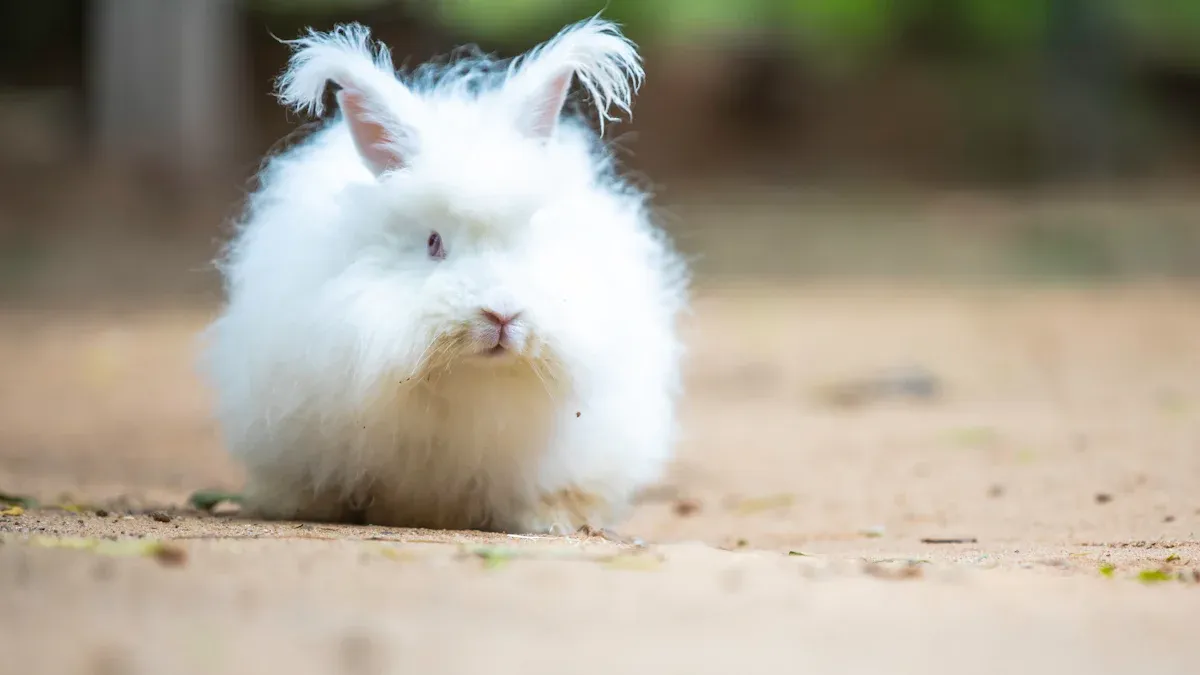
Animal Welfare
When you buy angora fabric, think about how rabbits are treated. Many angora rabbits live on big farms in bad conditions. These rabbits often stay in small wire cages. The cages hurt their feet and stop them from moving around. Some farms use painful ways to get the fiber, like plucking. Plucking can scare and hurt the rabbits. Rabbits may get stressed, injured, or even die early. Most rules do not protect angora rabbits very well. Farms often forget to give clean homes, good food, or time with other rabbits. In some places, there are no rules to stop these bad things.
You can choose angora fabric from farms that treat rabbits kindly. These farms use gentle combing or shearing, not plucking. They give rabbits room to move and play. You can look for labels like the Responsible Wool Standard. This label means the farm follows rules for animal care. When you buy angora fabric from these farms, you help rabbits live better lives.
Many farms do not care for rabbits well.
Rabbits need clean homes, good food, and friends.
Ethical farms use gentle ways to collect fiber.
Look for labels like the Responsible Wool Standard.
Sustainability
Angora fabric can be good for the planet if made the right way. Angora rabbits do not need much space or food. But big farms can still hurt the environment. Bad care can cause overgrazing and pollution. Some farms use eco-friendly ways, like organic feed and natural dyes. Angora fabric is natural and breaks down safely when you throw it away.
You can help by picking angora fabric from small, kind farms. These farms use gentle ways to get the fiber and avoid harsh chemicals. They often share how they care for their rabbits. You can find this on sites like Etsy, where sellers talk about their farms. Buying slow fashion and hand-spun yarn also helps. If you do not want new angora, you can buy vintage or second-hand items. You can also try soft and eco-friendly options like Tencel or organic cotton.
Do not buy mass-produced angora from bad farms.
Check for ethical sourcing and where it comes from.
Support slow fashion and hand-spun yarn.
Try Tencel or organic cotton as other choices.
Tip: When you pick angora fabric from kind farms, you help rabbits and the earth.
Angora is known for being soft, warm, and having a fluffy look. This makes angora fabric popular with knitters who want comfort. If you pick angora, try to find long fibers or blends that last longer. Angora fabric does not get dirty or wet easily, so you do not need to wash it much.
Wash angora fabric by hand in cold water using wool soap.
Lay angora fabric flat to dry and store it flat to keep its shape.
Take off lint carefully so angora fabric stays nice.
Tip: Choose angora fabric from kind sources to help rabbits and feel real comfort.
FAQ
What makes angora different from other animal fibers?
You will notice that angora feels much softer and lighter than most animal fibers. Angora comes from rabbits, not sheep or goats. The hollow core in each fiber helps angora keep you warm. The fluffy halo gives angora fabric a unique look.
How do you care for angora fabric?
You should wash angora fabric by hand in cold water. Use a gentle wool soap. Lay angora fabric flat to dry. Avoid wringing or twisting. This helps angora fabric keep its shape and softness.
Can you wear angora if you have allergies?
Many people with wool allergies can wear angora. Angora fibers have fewer scales, so they do not itch as much. Angora fabric feels gentle on your skin. If you have severe allergies, test a small piece of angora fabric first.
Why does angora fabric have a fluffy look?
The fluffy look comes from the fine, hollow fibers in angora. These fibers create a soft halo around angora fabric. This halo traps air, making angora fabric warmer and softer. The effect grows stronger as you wear or wash angora fabric.
Is angora fabric eco-friendly?
Angora fabric can be eco-friendly if you choose it from small, responsible farms. Angora rabbits need little space and food. Look for angora fabric made with gentle harvesting methods. This helps protect both the rabbits and the environment.




